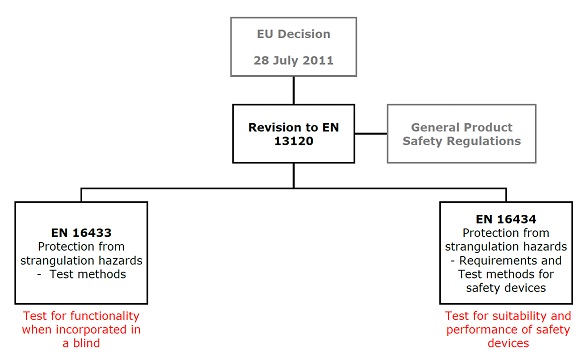
|
窗帘测试服务 Window Coverings / Window Blinds Testing Services
美国:
符合美国窗帘制造商协会(WCMA)的新修订标准 Complying with the Revised WCMA Standard
ANSI/WCMA A100.1-2012 AMERICAN OF NATIONAL STANDARD FOR SAFETY OF CORDED WINDOW COVERING PRODUCT
新标准公布日期:2012年11月30日
旧标准取消日期:新标准即时替代临时标准
多年来,消费者和企业在选购罗马帘、卷帘和各种有绳窗帘时,一般都只注重窗帘的大小、款式和颜色。然而,在1999至2011年间共发生276宗与所有种类有绳窗帘尤关的意外,当中140宗更引致死亡。频生的意外引发各界对窗帘的安全问题的关注,并带出制定更严谨的安全要求的需要,务求减低用者使用这类窗帘可能引致被勒死的危险性。
有见及此,美国消费品安全委员会 (Consumer Product Safety Commission , CPSC) 已回收数百万件有绳窗帘,同时敦促业界处理这个问题。美国窗帘制造商协会 (Window Covering Manufacturers Association, WCMA) 于是对《ANSI/WCMA A100.1 有绳窗帘产品安全标准》(Standard for Safety of Corded Window Covering Products) 作出了重大修改,这意味着早前出售的有绳窗帘很可能不再合规。这对制造商和零售商产生即时的影响,他们必须在新要求目前于2013年6月1日的生效期前符合标准,才可销售窗帘产品。
我们的实验室已具备《ANSI/WCMA》的新标准测试能力,能按标准内适用于您产品的章节对产品作出评估,包括明确规定的基质含铅量测试 (lead in substrate testing) 、紫外光老化测试 (UV aging test) 和循环测试 (cycling test) 。
1)什么类型的窗帘受到新修订的标准所影响?
新标准适用于所有有绳窗帘,包括现货和代客订制的产品。根据该标准所列,窗帘包括蜂窝帘 (cellular shades) 、百叶帘 (horizontal blinds)、百褶帘 (pleated shades)、卷帘 (roll-up blinds)、滚筒帘 (roller shades)、罗马帘 (Roman style shades)、横杆 (traverse rods) 和垂直帘 (vertical blinds)。
2)我需要重新设计我的产品吗?
窗帘是否需要作出改动,要视乎其类型和产品特性。就卷帘而言,不一定需要完全重新设计,但需要加上合规的放绳装置。至于其他类型的窗帘,例如威尼斯帘 (Venetian blinds) ,蜂窝帘和滚筒帘,这些产品可能不用重新设计,但需要在某些方面作出调整。例如,使用回圈窗帘绳或珠链拉绳的窗帘产品,张紧装置 (tension device) 需要按要求作出修改。
3)这只是业界标准,并不须强制遵守的吧?
虽说该标准只是由业界订立而并非法规,然而美国消费品安全委员会清楚指明窗帘必须符合最新版本的标准。2009年,数百万计的罗马帘和卷帘被回收;2010年11月,一名婴幼儿被窗帘绳子勒脖而死,引发起一场大规模的窗帘回收。所以,未能合乎2012年标准的产品有可能被要求强制遵守,并被美国消费品安全委员会要求回收产品。
4)有关本标准更新通知的重要信息?
a.增加绳子拉紧/控制装置的耐久性和性能测试要求,包括锚定、特殊安装说明和警告语最新要求。
b.提供一个方法处理不是使用拉紧装置去控制拉绳的创新产品。
c.增加针对使用宽的带子升起和降低的窗帘产品的新要求。
d.窗帘产品的包装和销售材料的外部要求安全警告语和象形图。
e.增加可接近拉绳和有危险绳圈测试的扩大测试、卷帘的性能测试和所有安全装置的耐久性测试。
欧盟:
EN 16434:2014
欧洲标准化组织CEN于2014年2月19日发布了百叶窗新安全标准。标准将于发布六个月后实施全。
欧洲标准化协会此次发布的百叶窗新安全标准共有三项:
EN 13120:2009+A1:2014 百叶窗 - 性能和安全要求 Internal blinds – Performance requirements including safety.
EN 16433:2014 百叶窗 - 防缠绕风险 - 测试方法 Internal blinds – Protection from strangulation hazards - Test methods.
EN 16434:2014 百叶窗 - 防缠绕风险 - 安全设备要求和测试方法 Internal blinds – Protection from strangulation hazards – Requirements and Test methods for safety devices.
这三项标准由欧盟标准化协会“门、窗、百叶窗、建筑五金和幕 墙技术委员会”(CEN/TC 33)下的“百叶窗工作组”(WG 3)制定,不久将被欧盟官方公报引用。标准的制定过程参考了生产企业、测试实验 室以及由欧洲消费者标准化之声提名专家的意见,并且参照了澳大利亚、 加拿大、美国等地区的相关安全法规和标准的要求。符合这三个标准的产品将被认为符合欧盟《通用产品安全按指令》(2001/95/EC)的要求。
EN 13120:2009+A1:2014是对欧洲标准 EN 13120:2009 修订版。欧洲标准 EN 13120:2009 规定了安装在墙体内的百叶窗需要符合的安全要 求。与旧版相比,新版标准覆盖范围扩大,不仅适合于活动百叶窗、卷帘、垂直帘,而且适用于蜂巢帘、罗马帘、奥地利/带穗花缎百叶窗等产品。此外,新标准还针对危险拉绳扩大了“纺织缠绕风险”的条款。
EN 16433:2014 是新制定的标准,规定了“防止缠绕”的测试方法, 用于验证产品符合欧洲标准EN 13120中的相关条款。
EN 16434:2014 则规定了百叶窗产品上安全设备的安全要求和测试方法。

英国窗帘标准:
BS 3415:1986 Specification for venetian blinds - 此标准以撤销
BS 5867:2008 关于窗帘及幕布等纺织品质量要求
标准要求每批货或每5000米样品必须抽取样品进行BS 5867要求项目测试。标准包括两部分内容。
第一部分(BS 5867-1:2004)是总则要求,主要包括色牢度测试、洗后尺寸变化和标签要求。产品经过水洗和干洗前处理后(除非面料标明不适合水洗或干洗),对色牢度和尺寸变化进行测试评定,具体评定要求具体如下:

第二部分(BS 5867-2:2008)是对窗帘、幕布等织物或制成品的燃烧性能要求。
前处理要求:
对于任何适合水洗的面料必须在符合BS EN ISO 10528洗标程序下进行12次水洗前处理;
对于任何适合干洗的面料必须执行BS EN 1021-1:2006,Annex 6浸泡程序然后进行6次干洗前处理(如果不适合干洗则必须浸泡程序);
对于不适合洗标前处理的必须加注洗标警告标识。
判定要求:
BS 5867-2:2008对于不同的等级要求及使用场所给出TYPE A,TYPE B,TYPE C三种不同测试方法。三种测试方法基本一致,对应的点火时间分别是:
TYPE A:10S;
TYPE B:15S;
TYPE C:5s, 15s, 20s, 30s。
需要指出的是TYPE C主要适用医院,疯人院等特殊场所(DHSS),并要求做50次水洗前处理。另外,不同的测试方法对结果判定有不同的方法具体请与我们TECERT取得联系。
加拿大
加拿大新拉绳窗强制标准进入最后投票阶段
2014年2月,加拿大标准机构 CSA 的拉绳窗相关技术委员会将新CSA Z 600标准草案进行最后一轮投票,整个过程将持续30天。若通过,则拟于2014年8月正式发布,并成为拉绳窗进入加拿大的新的强制性标准。现行的CSA Z 600-08以ANSI/WCMA A100.1-2007为蓝本,而目前ANSI/WCMA A100.1-2007已修订了三轮,与CSA Z 600-08有了较大的不同,此次CSA Z 600 标准的修订草案基本以ANSI/WCMA A100.1-2012为蓝本。较之前的版本,CSA Z 600 标准的修订草案在测试要求和警告标识上有较大的不同,如危险绳圈测试;拉紧和控制装置的耐久性测试等。
附录1:
FAQs - BS EN 13120
1) Where do the new rules apply?
Where internal blinds are installed in premises where children aged from 0 to 42 months are likely to have access or to be present. Examples are homes, hotels, hospitals, churches, shops, schools and general public places. The new standards also apply when the destination of the blind is unknown.
2) Are there any exceptions?
It does not apply where internal blinds are installed in premises where children are unlikely to have access. Examples are factories, laboratories etc. in these cases specific labels must be use as notice of this.
3) When does BS EN 13120:2009+A1:2014 come into effect?
When the BSI (Bristish Standards Institute) publish the document it is in the public domain and effective immediately. This was on the 28th February 2014.
4) Is there a period of grace or lead in period?
Normally there is a lead in period in cases like these. However, BS EN 13120 will be monitored by UK Trading Standards. Advice from the Department for Business Innovation and Skills is “Although a six month lead in period is not written in stone it is what is generally accepted, and any action by Trading Standards will be proportionate” and from Trading Standards “whilst the group thought that a transitional period would be sensible it did not prescribe any duration for such a period.”
The best advice from all parties is to be compliant as soon as possible.
5) Can I Use Evans Safety Devices with Other Blind Systems?
The simple answer is yes as they have passed EN 16434, however in order to comply with the Internal Blinds Performance Requirements they have only been tested as compatible with Evans Roman Headrails. Therefore it is the responsibility of anyone buying individual components from various suppliers to have their end product tested to BS EN 13120.
6) Baton Type Systems – Can these be made compliant?
Yes. However as Evans are not supplying the baton and a multitude of products can be used to make the blind, we can’t test and certify our products. Therefore it is the responsibility of anyone buying individual components from various suppliers to have their end product tested to BS EN 13120.
The basic rules apply, the cleat must be 150cms from the floor and accumulate all/most of the cord – only a single cord of no more than 20cms can hang below the cleat. Breakaway devices must also be used as per the section “Accessible Inner Cords” above. Also extra cord devices will be needed at the top of the blind to prevent the pull cord from creating a hazardous loop at the rear of the blind.


